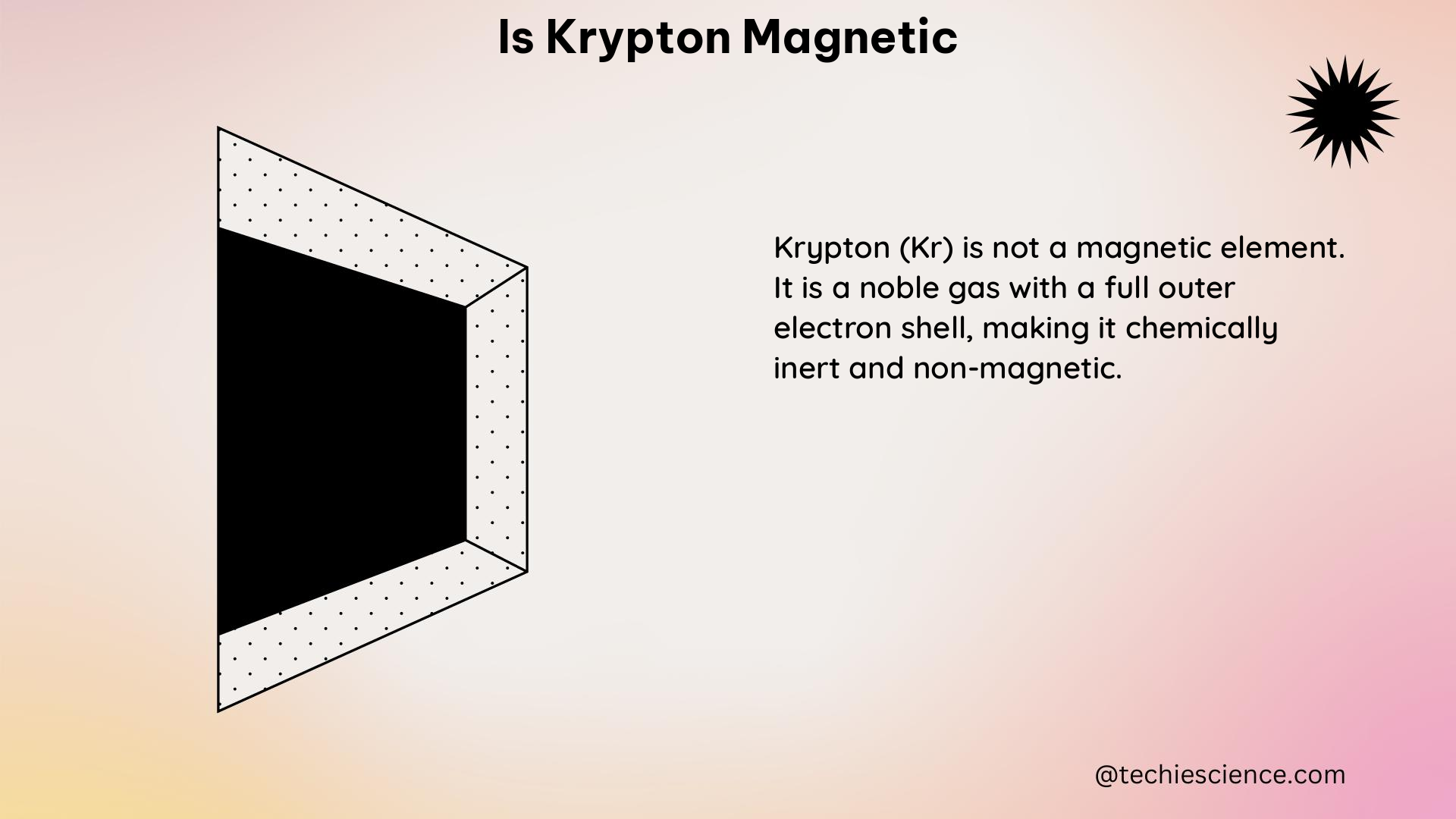Krypton is a noble gas with the symbol Kr and atomic number 36. It is a colorless, odorless, and tasteless gas that is highly unreactive due to its completely filled outer electron shell. When it comes to the magnetic properties of krypton, the answer is clear – krypton is not magnetic.
Understanding Krypton’s Atomic Structure
Krypton is a member of group 18 (the noble gases) in the periodic table. Its atomic structure is characterized by a completely filled outer electron shell, which means that all of its electrons are paired. This configuration makes krypton highly stable and unreactive, as it has no unpaired electrons that could participate in chemical reactions.
The electronic configuration of krypton is [Ar] 3d^10 4s^2 4p^6, where [Ar] represents the electron configuration of argon (1s^2 2s^2 2p^6 3s^2 3p^6). This means that krypton has a total of 36 electrons, with 10 electrons in the 3d orbital, 2 electrons in the 4s orbital, and 6 electrons in the 4p orbital.
Magnetic Properties of Krypton

For a substance to be magnetic, it must have unpaired electrons. These unpaired electrons create a magnetic moment, which is the source of the material’s magnetic properties. However, krypton, as a noble gas, has a completely filled outer electron shell, with all of its electrons paired.
According to Hund’s rule, the most stable electron configuration is the one with the maximum number of unpaired electrons. Since krypton has no unpaired electrons, it does not exhibit any magnetic properties. This means that krypton is a diamagnetic substance, which means that it is slightly repelled by an external magnetic field.
Theoretical Explanation of Krypton’s Non-Magnetic Behavior
The lack of magnetic properties in krypton can be explained using the principles of quantum mechanics and the theory of magnetism.
Diamagnetism in Krypton
Diamagnetism is a fundamental property of matter that arises from the motion of paired electrons in an atom or molecule. When an external magnetic field is applied, the paired electrons in krypton’s outer shell will experience a small induced magnetic moment in the opposite direction to the applied field, resulting in a weak repulsion from the magnetic field.
This diamagnetic behavior can be quantified using the magnetic susceptibility, which is a measure of how a material responds to an external magnetic field. The magnetic susceptibility of krypton is very small and negative, indicating its diamagnetic nature.
Absence of Unpaired Electrons
As mentioned earlier, the presence of unpaired electrons is a necessary condition for a material to exhibit magnetic properties. Krypton, with its completely filled outer electron shell, has no unpaired electrons. This means that there are no net magnetic moments associated with the individual krypton atoms, and the material as a whole does not exhibit any magnetic behavior.
Comparison with Other Noble Gases
The other noble gases, such as helium, neon, argon, xenon, and radon, also have completely filled outer electron shells and are therefore non-magnetic, just like krypton. This is a characteristic shared by all the noble gases due to their stable electronic configurations.
Applications and Importance of Krypton’s Non-Magnetic Properties
The non-magnetic nature of krypton has several important applications and implications:
-
Lighting and Displays: Krypton is used in certain types of high-intensity discharge lamps, such as xenon and krypton-filled lamps, which are used in automotive headlights, searchlights, and some types of projectors. The non-magnetic properties of krypton ensure that it does not interfere with the operation of these devices.
-
Cryogenics and Refrigeration: Krypton’s low boiling point (-153.22°C) makes it useful in cryogenic applications, such as the cooling of superconducting magnets and other low-temperature devices. Its non-magnetic nature ensures that it does not interact with the magnetic fields present in these applications.
-
Scientific Research: The lack of magnetic properties in krypton is important in various scientific experiments and research applications, where the presence of magnetic fields could interfere with the measurements or observations being made.
-
Inert Gas Mixtures: Krypton is often used in combination with other noble gases, such as xenon or argon, to create inert gas mixtures for specialized applications. The non-magnetic nature of krypton ensures that it does not affect the overall magnetic properties of these mixtures.
Conclusion
In summary, krypton is a non-magnetic noble gas due to its completely filled outer electron shell, which results in the absence of unpaired electrons. This diamagnetic behavior of krypton is a fundamental property that has important implications in various applications, from lighting and cryogenics to scientific research and inert gas mixtures.
References
- “Krypton Atom – an overview | ScienceDirect Topics.” https://www.sciencedirect.com/topics/chemistry/krypton-atom
- “Technical data for the element Krypton in the Periodic Table.” https://periodictable.com/Elements/036/data.html
- “Measurable Quantity – an overview | ScienceDirect Topics.” https://www.sciencedirect.com/topics/engineering/measurable-quantity
- “Krypton – Element information, properties and uses | Periodic Table.” https://www.rsc.org/periodic-table/element/36/krypton
Hi, I’m Akshita Mapari. I have done M.Sc. in Physics. I have worked on projects like Numerical modeling of winds and waves during cyclone, Physics of toys and mechanized thrill machines in amusement park based on Classical Mechanics. I have pursued a course on Arduino and have accomplished some mini projects on Arduino UNO. I always like to explore new zones in the field of science. I personally believe that learning is more enthusiastic when learnt with creativity. Apart from this, I like to read, travel, strumming on guitar, identifying rocks and strata, photography and playing chess.